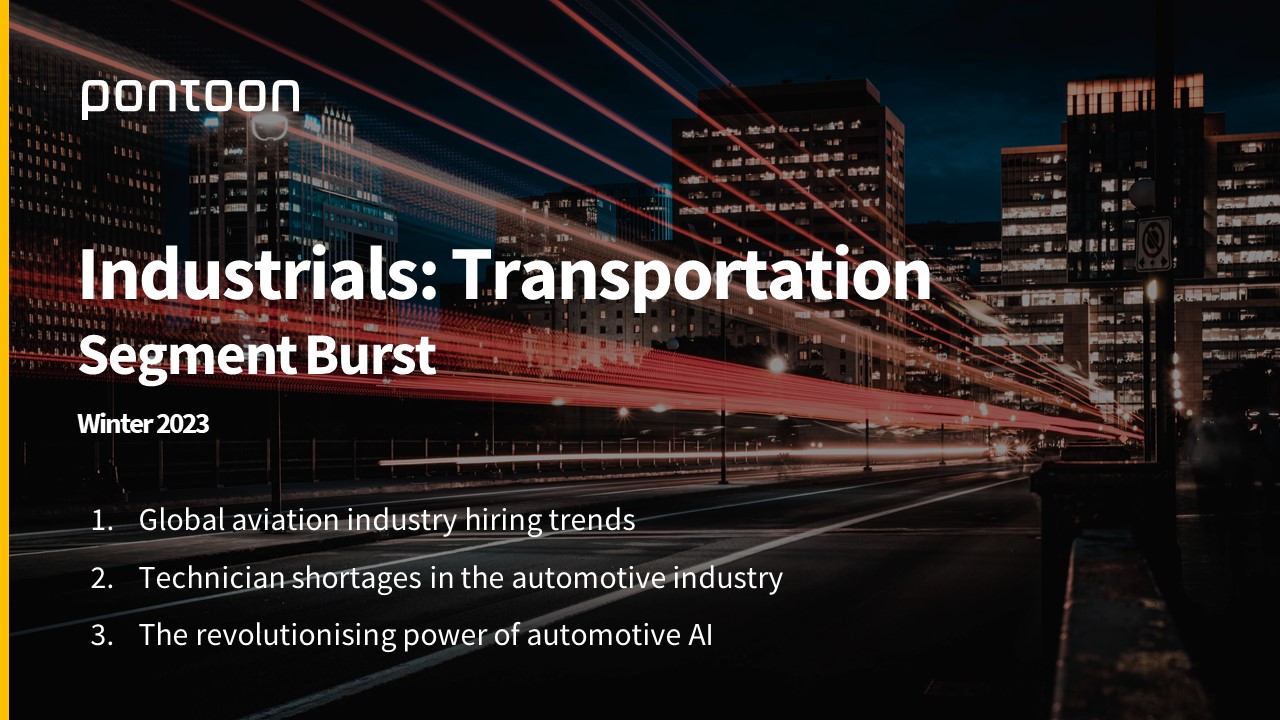Industrials Segment Burst: Winter 2023
Research
.
In the Winter 2023 volume of Industrials Segment Burst, we explore the most recent trends in transportation.
Global aviation industry hiring trends
In 2023, the aviation industry will be back in the black for the first time since the onset of the pandemic. Experts estimate that the segment’s collective net income will amount to 4.7 billion USD while revenue is expected to reach 779 billion USD. For the first time since 2019, the number of passengers will exceed 4 billion persons.
As the industry recovers financially, the repercussions of the Covid-19 layoffs continue to impede its growth. The risk of talent shortages in the industry is high, with problems found across all job types, including scarcity of ground staff, airline and airport personnel, and air traffic control.
However, it is the pilot shortage that will be the most pressing issue in 2023. To counter that trend, some airlines are already establishing their own flight academies to educate the next generation of pilots. Meanwhile, improved pay rates and schedules that allow for better employee wellbeing are key to attracting and retaining pilots.
Apart from airline personnel, the aviation industry will see a growing demand for technical roles. AI, biometrics, and cloud engineering are expected to become more prominent in passenger self-service platforms and electronic boarding systems. In the next decade, passenger services will likely evolve towards AI-powered self-service operations based on biometrics and cloud technology.
Aircraft designers and experts in sustainable aviation will be also working hard in the upcoming years to propose new engine concepts, wing designs, electric aircraft development plans, and green aircraft technologies that can align with net zero transition goals. As such, the portfolio of roles, skills, and cross-disciplinary training needed in the industry is expected to grow significantly.
Technician shortages in the automotive industry
The automotive industry is facing talent shortages in both gasoline-powered motor vehicles and electric vehicle sectors.
Electric vehicles talent shortage
In Britain, the number of technicians qualified to work on electric vehicles (EVs) adds up to slightly under 33,000 persons. That number needs to be tripled to ensure proper maintenance without drastically raising servicing costs. By 2030, the EV industry in Britain will need 90,000 qualified technicians.
Meanwhile, in the US, the demand for EV-industry-trained electricians is expected to grow by 7% by 2031, which translates to an average of 79,900 job openings every year. The growing demand for skilled talent is prompted by the deployment of EV chargers across the country as part of the National Electric Vehicle Investment (NEVI).
To evade the talent crisis, leaders in the electric vehicle space should be prepared to offer upskilling, reskilling, and industry-specific training to candidates sourced from other industries, including software development, aerospace, and consumer electronics.
Collision repair technician shortage
Auto collision repair business in the US faces a technician talent shortage. In the next three years, 113,000 entry-level collision technicians will be needed on the job market. This demand is not easy to meet given that senior workers are nearing retirement and only approx. 4,500 young people complete post-secondary collision programmes each year.
To attract prospective employees and ensure knowledge transfer between senior workers and the next generation of talent, companies and associations should organise apprenticeship programmes and workshops where students can learn vehicle assembly, disassembly, plastic repair, and small dent repair.
Launching or leveraging industry-aligned talent attraction websites is another way to spark interest in the field, but collaboration with technical schools and repair facilities will expand access to workers that can support more efficient operations.
The revolutionising power of automotive AI
The automotive artificial intelligence market is expected to grow in the upcoming years at a 21.6% compound annual growth rate, reaching over 14 billion USD by 2030.
While autonomous vehicles (AVs) are still largely a matter of the distant future, with the number of self-driving cars estimated to reach 6,500 vehicles in 2035, AI continues to streamline today’s automotive production. New technologies increase both driver and pedestrian safety through real-time monitoring systems, object/pedestrian detection, and Internet of Things sensors that can conduct driver behaviour analysis and issue warnings when needed.
Apart from improving production, quality, and safety, AI will be crucial to the automotive industry’s profitability in the upcoming years. Using sale and post-sale vehicle data for predictive modelling will allow automotive leaders to adjust production to demand, thus empowering them to adequately respond to real-world global supply chain crises.
AI is also expected to increasingly facilitate sales through conversational platforms and context-aware systems, which points to the indispensability of new technologies also in downstream stages of the supply chain.
As the automotive industry continues to advance with new technologies, there is a growing need for AI tech specialists who can design, develop, and implement these cutting-edge solutions.
Strategies for attracting automotive AI specialists
- Make AI and digital transformation an intrinsic part of your EVP to attract the talent you need.
- Create job descriptions that position your automotive company as a digital transformation leader.
- Consider candidates with transferrable skills from other shrinking industries, especially as they lay off their staff.
- Offer industry-specific training and upskilling for highly-qualified talent sourced from other industries.
Related Post
Read about top trends in the world of work.
In this month’s instalment of our Market Burst, we dive into the trends that will drive talent management in 2023. These include ...





